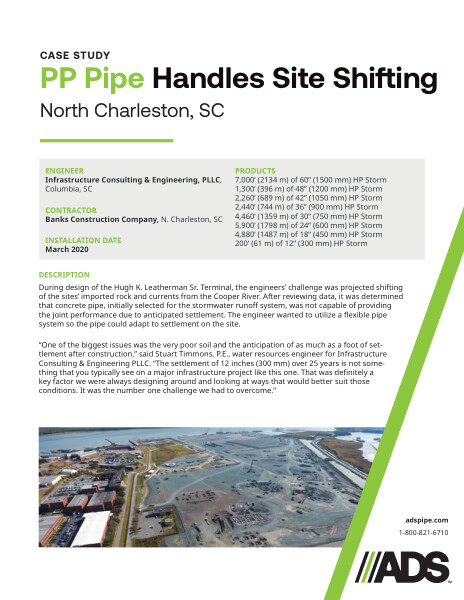PP Pipe Handles Site Shifting (North Charleston, SC) Case Study)
Filename:
PP Pipe Handles Site Shifting (North Charleston, SC) Case Study).pdf

This document is the case study for the Hugh K. Leatherman Terminal. Shifting the site’s rock and currents from Cooper River for the new terminal discussed.
During design of the Hugh K. Leatherman Sr. Terminal, the engineers’ challenge was projected shifting of the sites’ imported rock and currents from the Cooper River. After reviewing data, it was determined that concrete pipe, initially selected for the stormwater runoff system, was not capable of providing the joint performance due to anticipated settlement. The engineer wanted to utilize a flexible pipe system so the pipe could adapt to settlement on the site.
The big issue was the very poor soil and the anticipation of as much as a foot of
settlement after construction. The settlement of 12 inches (300 mm) over 25 years is not something that you typically see on a major infrastructure project like this one. That was a key factor when designing around and looking at ways that would better suit those conditions.
HP Storm polypropylene pipe was used because the stiffness of the pipe was suited for the site’s conditions and joints are double gasketed and has secure joint performance, to flex with the soil and provide strength, while being easy to handle. Over 28,000 feet (8,534 m) of HP Storm was used for stormwater conveyance on the 280-acre site.
In addition to its flexibility, HP Storm met the strength and drainage requirements of the site. The storm drain system is designed for a 10-year storm and needs to carry runoff for more than a mile with a minimum slope of 0.33 percent. The system also had to be able to withstand live and dead loads much greater than an average highway project. In addition to typical heavy equipment found at a container terminal, a loader container handler is rated at nearly 92,000 pounds (41,730 kg) per axle.
HP Storm saved months of installation time versus the time and manpower that is required of concrete pipe and culverts verses another alternative, corrugated steel, that with the rock it’s a corrosion-type thing. Plus, it’s not as sturdy where you need a double-wall installation.
Photographs of the project are included.
